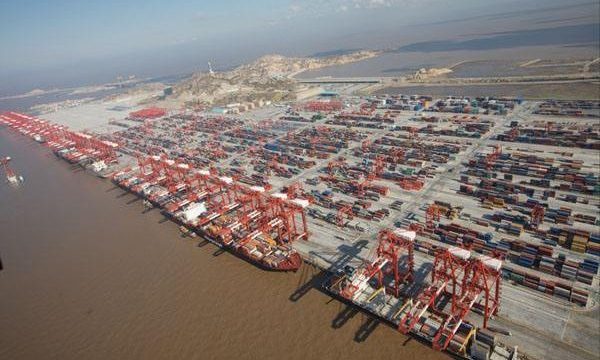 [[{“value”:”
[[{“value”:”

A new study by Scope3 emissions tracking specialist VesselBot reveals that greenhouse gas (GHG) emissions at major global ports continue to rise despite technological advancements and sustainability investments.
The report shows Shanghai port recorded the highest emissions (see chart below) at 140,000 tons, surpassing Singapore despite handling fewer vessels, highlighting that vessel numbers don’t directly correlate with emission levels.
Port congestion and inefficient operations significantly impact emissions, with US ports reporting the highest congestion levels, particularly in January and February 2025, driven by preemptive shipping ahead of new tariff implementations.
“This report reveals the complex relationship between port activity and emissions,” said Constantine Komodromos, CEO and founder of VesselBot. “Our data shows that while more vessels generally mean more emissions, performance and operational efficiency are crucial mitigating factors.”
The study quantifies how port shape, terminal availability, vessel dwell times, and engine utilisation during idle periods significantly influence emission levels beyond simple vessel counts.
Research published last year by the Hong Kong University of Science and Technology (HKUST) shows the potential lives saved from more coordinated port arrivals.
Over several years, HKUST studied the impact of maritime emissions on mortality, concluding that 90,000 premature deaths worldwide annually can be attributed to air pollution from ships. The university has since studied a sub-set of those emissions: the emissions caused by the practice of sailing fast and then waiting, and concluded that for every 1% of anchorage emissions reduced, around 400 premature deaths worldwide can be avoided. Getting rid of the sailing fast then waiting practice entirely could prevent more than 10,000 premature deaths annually, the research showed.
Another related study published last year made a strong case for shore power at ports across the world.
Issued by the International Council on Clean Transportation (ICCT), an NGO from Washington DC, the study is the first nationwide American port emissions screening for at-berth vessels. Using the ICCT’s systematic assessment of vessel emissions model and automatic identification system (AIS) data, the study estimated how much pollution is emitted by at-berth vessels and then researchers identified US ports where investments in shore power could meaningfully improve air quality in nearby communities.
The study’s estimates show that in the absence of shore power, at-berth vessels emitted approximately 27,000 tonnes of combined air pollutants (NOX, SOX, and PM10) and more than 1.4m tonnes of CO2 in 2019. Of the 129 ports considered in this analysis, 43 high-priority ports and port groups overlapped with lower-income census tracts and areas that do not meet US Environmental Protection Agency air quality standards.
The 22-page working paper makes a strong case for shore power – also known as cold ironing or alternative maritime power – to allow at-berth vessels to plug into the local electrical grid and turn off auxiliary engines that would otherwise burn fossil fuel to power essential operations and emit greenhouse gases and air pollutants.

The post Shanghai port pollution in the spotlight appeared first on Energy News Beat.
“}]]
